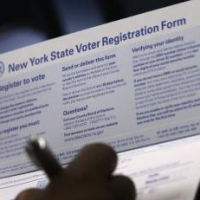Late Political Party Registrants in New York Found 19th Century Law Stood in Their Way
 (photo: John Moore, Getty Images)
(photo: John Moore, Getty Images)
By Nicholas Confessore, New York Times
In recent days, thousands of New Yorkers, including many avowed supporters of Sen. Bernie Sanders of Vermont, discovered that they couldn’t vote in the Democratic and Republican primaries Tuesday. The reason: Under a New York law dating to the late 1800s, independent voters would have had to register with one of the two parties last October in order to be able to cast a vote in the primary.
Some Sanders supporters suggested such rules were a way for party leaders to hamstring insurgents like the Vermont senator. But according to Douglas A. Kellner, an election lawyer who is a Democratic commissioner on the New York Board of Elections, the rules were originally intended as a strike against the manipulations of party bosses and political machines.
More than a century ago, party bosses not only picked the candidates, they would pick their voters, too, stripping uncooperative voters of their party registration at a whim to protect their own power, or on suspicion that the voter might not agree with the bosses. At the time, party members picked party leaders, who in turn picked candidates for the general election.
“Prior to the reform of the primary election law, the parties would kick out insurgents from the party membership, or bring in ringers to the party membership, to influence the selection of the party ticket,” Kellner said.
But in the 1890s, Kellner said, reformers succeeded in passing a spate of laws intended to take control of elections away from bosses and machines. The government, not the party, would run elections, print ballots and handle party enrollment. Anyone could join a party by depositing an enrollment form in a locked box that was left out by election officials in a given jurisdiction until about a month before each year’s general election. On the first Tuesday after that general election, the box was unlocked and the voter’s new enrollment would be added to the state’s official registration books. That person could then vote in the following party primary, many months hence.
The law survived a 1972 Supreme Court challenge, Rosario v. Rockefeller, in which some New York voters claimed that the rule had effectively disenfranchised them. Kemp Hannon, now a New York state senator from Long Island, was among the lawyers defending the rule. Hannon and his colleagues argued that the original laws were intended to prevent “party raiding,” in which members of one party switch to an opposing party en masse, hoping to force the opposing party to select a weaker candidate for the general election candidate.
“Candidates would go in and try to get their own people to sign up for a party,” Hannon said in an interview. Making voters pick their future party enrollment just before a general election, the defense lawyers argued, helped inhibit that kind of gamesmanship.
The court agreed with this argument, finding that the state had an interest in preventing party raiding. And notwithstanding some tweaks, both the rule and the idea of the enrollment box are still enshrined in state law.
“A change of enrollment received by the board of elections not later than the twenty-fifth day before the general election shall be deposited in a sealed enrollment box, which shall not be opened until the first Tuesday following such general election,” reads section 5-304 of New York’s election law. “Such change of enrollment shall be then removed and entered as provided in this article.”
“Today, it gets filed immediately,” said Kellner, referring to the change in party registration. “But legally, there’s a law about a box.”
To Learn More:
Thousands of Independent-Minded California Voters Mistakenly Registered with Conservative Party Due to Name Confusion (Associated Press)
New Registration Law Could Add 6.6 Million People to Voter Rolls (by Ken Broder, AllGov California)
Federal Judge Supports North Carolina Voter Restrictions (by Noel Brinkerhoff and Steve Straehley, AllGov)
- Top Stories
- Unusual News
- Where is the Money Going?
- Controversies
- U.S. and the World
- Appointments and Resignations
- Latest News
- Trump to Stop Deportations If…
- Trump Denounces World Series
- What If China Invaded the United States?
- Donald Trump Has a Mental Health Problem and It Has a Name
- Trump Goes on Renaming Frenzy






Comments